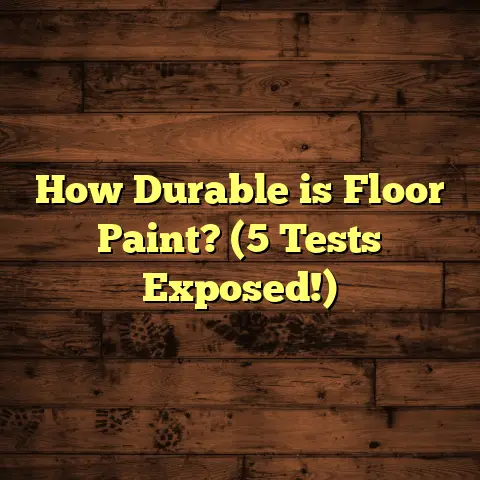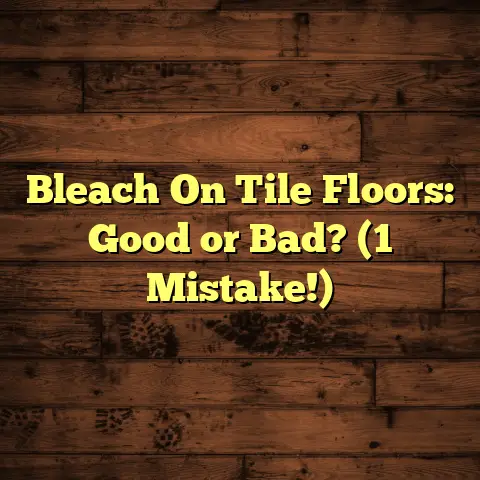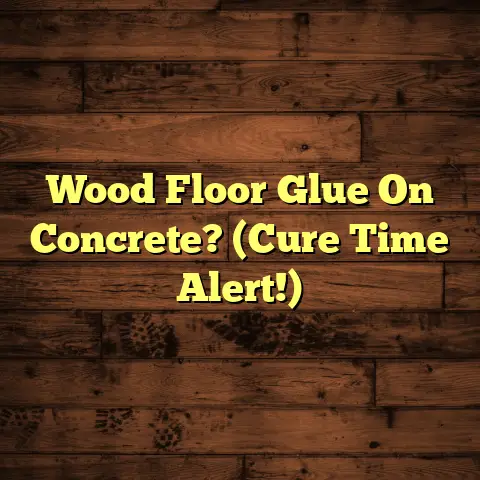Clean Stained Concrete Floors (6 Stain Busters!)
I get it. I’ve been in the flooring business for over 15 years, and I’ve seen it all. Concrete floors are fantastic – durable, stylish, and perfect for modern living. But they’re not immune to the occasional mishap.
Think of your concrete floors as a canvas of memories. Family gatherings, kids’ art projects, maybe even a pet accident or two. These floors hold stories, but sometimes, those stories are written in unsightly stains.
But don’t worry! You don’t have to live with those blemishes. I’m going to share my top 6 “Stain Busters” to help you reclaim your beautiful concrete floors and bring back that warm, inviting feeling to your home.
Ready to dive in? Let’s get started!
1. Understanding Concrete Stains: The Root of the Problem
So, what exactly are concrete stains? Simply put, they’re discolorations that penetrate the porous surface of the concrete. Unlike a stain on your shirt that sits on the fabric, concrete stains seep in, making them trickier to remove.
Common Causes of Concrete Stains:
- Spills: Oil, grease, wine, coffee – the usual suspects.
- Weathering: Rain, snow, and sun can cause mineral deposits and fading.
- Mold & Mildew: Damp environments breed these unpleasant organisms.
- Rust: Metal objects left on the concrete can leave unsightly rust stains.
- Organic Matter: Leaves, dirt, and other organic debris can break down and stain the surface.
Different Types of Stains, Different Challenges:
- Oil Stains: These are often dark and greasy, requiring degreasing agents.
- Rust Stains: These reddish-brown stains need acidic cleaners to break them down.
- Mildew Stains: These are usually black or green and require bleach or mildew-specific cleaners.
- Food Stains: Coffee, wine, and juice stains often require enzymatic cleaners.
I remember one time, a client of mine, Sarah, called me in a panic. Her kids had spilled a whole bottle of red wine on their newly sealed concrete floor during a party. She’d tried everything, but the stain just wouldn’t budge. That’s when I knew she needed a more targeted approach.
The point is, identifying the type of stain is crucial for choosing the right cleaning method.
2. Stain Buster #1: The Power of Soap and Water
Don’t underestimate the power of a good ol’ soap and water solution! This method is perfect for tackling light, surface-level stains and general cleaning.
Step-by-Step Instructions:
- Gather Your Supplies: You’ll need a bucket, warm water, a mild dish soap (I prefer Dawn), a scrub brush, and a mop.
- Mix the Solution: In your bucket, mix a few drops of dish soap with warm water. You want a sudsy solution, but not overly soapy.
- Apply the Solution: Pour the soapy water onto the stained area.
- Scrub: Use your scrub brush to work the solution into the concrete. Apply moderate pressure and scrub in a circular motion.
- Rinse: Rinse the area thoroughly with clean water. Make sure to remove all traces of soap.
- Mop: Use a clean mop to remove any excess water.
- Dry: Allow the area to air dry completely.
Tips for Success:
- Use Mild Soap: Avoid harsh chemicals or abrasive cleaners, as they can damage the concrete surface.
- Test in an Inconspicuous Area: Before cleaning the entire floor, test the solution in a hidden area to ensure it doesn’t cause discoloration.
- Don’t Over-Saturate: Avoid using too much water, as it can seep into the concrete and cause further damage.
- Rinse Thoroughly: Soap residue can attract dirt and make the problem worse.
I’ve seen this simple method work wonders on everyday dirt and spills. It’s a great first line of defense!
3. Stain Buster #2: Baking Soda Magic
Baking soda is a natural wonder! Its mild abrasive properties make it an excellent stain remover, and it’s safe for both you and your concrete floors.
DIY Baking Soda Paste Recipe:
- 1/2 cup baking soda
- 1/4 cup water (add more if needed to form a paste)
How to Apply Effectively:
- Prepare the Paste: Mix the baking soda and water in a bowl until you have a thick paste.
- Apply to the Stain: Generously apply the paste to the stained area, ensuring it’s completely covered.
- Let it Sit: Allow the paste to sit on the stain for at least 30 minutes, or even longer for tougher stains. I sometimes leave it overnight.
- Scrub: Use a scrub brush or sponge to scrub the paste into the concrete.
- Rinse: Rinse the area thoroughly with clean water.
- Dry: Allow the area to air dry completely.
Real-Life Success Story:
I had a client, Mark, who had stubborn grease stains in his garage from years of working on cars. He’d tried everything, but nothing seemed to work. I suggested trying a baking soda paste. He was skeptical, but he gave it a shot. To his surprise, after leaving the paste on overnight and scrubbing the next day, the grease stains were significantly lighter! He was amazed by the results.
Baking soda is my go-to for those tricky, embedded stains. It’s gentle, effective, and readily available.
4. Stain Buster #3: Vinegar and Water Solution
Vinegar is a powerhouse when it comes to breaking down stains, and it’s an eco-friendly option too! Its acidity helps dissolve dirt, grime, and even some types of mineral deposits.
Detailed Recipe for Vinegar and Water Solution:
- 1 cup white vinegar
- 1 gallon warm water
Instructions:
- Mix the Solution: In a bucket, mix the vinegar and water.
- Apply to the Stain: Pour the solution onto the stained area.
- Let it Sit: Allow the solution to sit for 10-15 minutes.
- Scrub: Use a scrub brush or sponge to scrub the area.
- Rinse: Rinse thoroughly with clean water.
- Dry: Allow the area to air dry.
Precautions:
- Test First: Always test the solution in an inconspicuous area to ensure it doesn’t discolor the concrete.
- Dilute Properly: Never use undiluted vinegar on concrete, as it can be too acidic and damage the surface.
- Avoid on Sealed Concrete: Vinegar can strip the sealant off sealed concrete floors.
I often recommend vinegar for removing hard water stains and general grime. It’s a natural and effective cleaner that’s safe for most concrete surfaces.
5. Stain Buster #4: The Power of Commercial Cleaners
Sometimes, DIY methods just aren’t enough. For those tough, stubborn stains, commercial concrete cleaners can be a lifesaver. These cleaners are specifically formulated to penetrate and dissolve different types of stains.
Popular Brands:
- Simple Green Concrete & Driveway Cleaner: A biodegradable and non-toxic option for general cleaning and degreasing.
- Zep Concrete & Driveway Cleaner: A powerful cleaner for removing oil, grease, and rust stains.
- Krud Kutter Concrete & Driveway Cleaner: An all-purpose cleaner that’s effective on a variety of stains.
Features and Benefits:
- Targeted Formulas: Commercial cleaners are designed to target specific types of stains, making them more effective.
- Stronger Cleaning Power: They often contain stronger chemicals than DIY solutions, allowing them to tackle tougher stains.
- Convenience: They are readily available and easy to use.
User Testimonials:
I had another client, Tom, who tried everything to remove years of oil stains from his garage floor. He finally decided to try Zep Concrete & Driveway Cleaner. He was amazed by the results! The cleaner dissolved the oil stains with minimal scrubbing, leaving his garage floor looking almost new.
Important Note: Always follow the manufacturer’s instructions carefully when using commercial cleaners. Wear gloves and eye protection, and ensure proper ventilation.
6. Stain Buster #5: Pressure Washing for Heavy-Duty Cleaning
When all else fails, pressure washing can be a game-changer. This method uses high-pressure water to blast away dirt, grime, and even deeply embedded stains.
Process and Benefits:
- Deep Cleaning: Pressure washing can penetrate deep into the pores of the concrete, removing stains that other methods can’t reach.
- Efficiency: It’s a quick and efficient way to clean large areas of concrete.
- Restoration: Pressure washing can restore the original appearance of the concrete, making it look new again.
Safety Tips:
- Wear Protective Gear: Wear safety glasses, gloves, and closed-toe shoes.
- Start with Low Pressure: Begin with a low-pressure setting and gradually increase the pressure as needed.
- Keep a Safe Distance: Maintain a safe distance from the surface to avoid damaging the concrete.
- Avoid Directing the Spray at Yourself or Others: Pressure washers can be dangerous if misused.
Case Study:
I had a client, Lisa, who had a large concrete patio that was covered in years of dirt, algae, and mildew. She’d tried scrubbing it, but nothing seemed to work. I recommended pressure washing. After just a few hours, her patio looked brand new! She was thrilled with the results.
Pressure washing is a powerful tool, but it’s important to use it safely and responsibly.
7. Stain Buster #6: Professional Help—When to Call in the Experts
Sometimes, despite your best efforts, stains just won’t budge. Or, maybe you’re dealing with a particularly delicate or valuable concrete surface that you don’t want to risk damaging. That’s when it’s time to call in the professionals.
Scenarios Where DIY Might Not Suffice:
- Deeply Embedded Stains: Stains that have been present for a long time and have penetrated deep into the concrete.
- Large Areas: Cleaning a large area of stained concrete can be time-consuming and physically demanding.
- Delicate Surfaces: Polished, stained, or sealed concrete may require specialized cleaning techniques.
- Unknown Stains: If you’re unsure what caused the stain, it’s best to consult a professional.
What to Look for in a Professional Cleaning Service:
- Experience: Choose a company with a proven track record of cleaning concrete floors.
- Expertise: Make sure the company has experience dealing with the specific type of stain you’re facing.
- Equipment: The company should have the right equipment for the job, including pressure washers, specialized cleaners, and extraction tools.
- Insurance: Ensure the company is properly insured in case of accidents or damage.
Transformation Story:
I had a client, David, who had a beautiful stained concrete floor in his living room. However, a leaky pipe had caused a large water stain that he couldn’t remove. He was worried about damaging the floor by trying to clean it himself. He called in a professional cleaning service, and they were able to remove the stain without damaging the delicate surface. He was so relieved and grateful.
Don’t hesitate to seek professional help when needed. It can save you time, money, and stress in the long run.
Conclusion: A Call to Action
Your concrete floors are more than just a surface; they’re an integral part of your home, holding memories and adding character to your living space. Don’t let unsightly stains diminish their beauty and the joy they bring.
Take pride in your home and implement the stain-busting methods I’ve shared with you. Start with the simple soap and water solution and work your way up to the more powerful methods if needed.
Remember, a clean, beautiful floor can restore not just the aesthetics of your space but also the warmth and inviting feeling that comes with it. Celebrate the small victories of cleaning and share the hope that your concrete floors can once again be a source of pride and cherished memories.
So, roll up your sleeves, grab your cleaning supplies, and get ready to transform your stained concrete floors into a sparkling canvas of memories! You got this!





